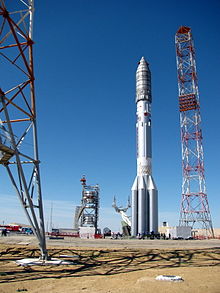
Back প্রোটন-এম Bengali/Bangla Proton-M Czech Proton-M Spanish پروتون-ام Persian Proton-M Finnish Proton M Galician פרוטון M HE Proton-M Croatian Proton-M ID プロトン-M Japanese
 Proton-M rocket on the launchpad at Baikonur Cosmodrome | |
| Function | Heavy-lift launch vehicle |
|---|---|
| Manufacturer | Khrunichev |
| Country of origin | Russia |
| Cost per launch | US$65 million[1] |
| Size | |
| Height | 58.2 m (191 ft) |
| Diameter | 7.4 m (24 ft) |
| Mass | 705,000 kg (1,554,000 lb)[2] |
| Stages | 3 or 4 |
| Capacity | |
| Payload to LEO[a] | |
| Mass | 23,000 kg (51,000 lb)[3] |
| Payload to GTO (1800 m/s) | |
| Mass | 6,920 kg (15,260 lb)[3] |
| Payload to GTO (1500 m/s) | |
| Mass | 6,300 kg (13,900 lb)[4] |
| Payload to GSO | |
| Mass | 3,250 kg (7,170 lb)[3] |
| Associated rockets | |
| Family | Universal Rocket (Proton) |
| Based on | Proton-K |
| Comparable | |
| Launch history | |
| Status | Active |
| Launch sites | Baikonur, Sites 81/24 & 200/39 |
| Total launches | 115 |
| Success(es) | 104 |
| Failure(s) | 9 |
| Partial failure(s) | 2 |
| First flight | 7 April 2001[5] |
| Last flight | 12 March 2023 |
| Type of passengers/cargo | GLONASS, ExoMars, Nauka |
| First stage – 8S810K | |
| Height | 21.18 m (69.5 ft)[6] |
| Diameter | 7.4 m (24 ft) |
| Empty mass | 30,600 kg (67,500 lb) |
| Propellant mass | 428,300 kg (944,200 lb) |
| Powered by | 6 × RD-275M |
| Maximum thrust | 10,532 kN (2,368,000 lbf) |
| Specific impulse | 285 s (2.79 km/s) |
| Burn time | 108 seconds |
| Propellant | N2O4 / UDMH |
| Second stage – 8S811K | |
| Height | 17.05 m (55.9 ft)[6] |
| Diameter | 4.1 m (13 ft) |
| Empty mass | 11,000 kg (24,000 lb) |
| Propellant mass | 157,300 kg (346,800 lb) |
| Powered by | 3 × RD-0210 1 × RD-0211 |
| Maximum thrust | 2,399 kN (539,000 lbf) |
| Specific impulse | 327 s (3.21 km/s) |
| Burn time | 206 seconds |
| Propellant | N2O4 / UDMH |
| Third stage – 8S812 | |
| Height | 4.11 m (13.5 ft)[7] |
| Diameter | 4.1 m (13 ft) |
| Empty mass | 3,500 kg (7,700 lb) |
| Propellant mass | 46,562 kg (102,652 lb) |
| Powered by | 1 × RD-0212 |
| Maximum thrust | 613.8 kN (138,000 lbf) |
| Specific impulse | 325 s (3.19 km/s) |
| Burn time | 238 seconds |
| Propellant | N2O4 / UDMH |
| Fourth stage (optional) – Briz-M | |
| Height | 2.61 m (8 ft 7 in) |
| Diameter | 4.0 m (13.1 ft) |
| Empty mass | 2,370 kg (5,220 lb) |
| Propellant mass | 19,800 kg (43,700 lb) |
| Powered by | 1 × S5.98M |
| Maximum thrust | 19.62 kN (4,410 lbf)[8] |
| Specific impulse | 326 s (3.20 km/s) |
| Burn time | 3,000 seconds |
| Propellant | N2O4 / UDMH |
| Fourth stage (optional) – Blok DM-2 | |
| Powered by | 1 × RD-58M |
| Maximum thrust | 85 kN (19,000 lbf) |
| Specific impulse | 352 s (3.45 km/s) |
| Propellant | RP-1 / LOX |
| Fourth stage (optional) – Blok DM-03 | |
| Powered by | 1 RD-58M/RD-58MF |
| Propellant | RP-1 / LOX |
The Proton-M, (Протон-М) GRAU index 8K82M or 8K82KM, is an expendable Russian heavy-lift launch vehicle derived from the Soviet-developed Proton. It is built by Khrunichev, and launched from sites 81/24 and 200/39 at the Baikonur Cosmodrome in Kazakhstan. Commercial launches are marketed by International Launch Services (ILS), and generally use Site 200/39. The first Proton-M launch occurred on 7 April 2001.[9]
Proton flew its most recent mission on 12 March 2023. As of August 2020, a number of Roscosmos and other Russian government missions remain on Proton launch manifest.
- ^ Surplus Missile Motors (PDF) (Report). United States Government Accountability Office. August 2017. GAO-17-609. Retrieved 27 November 2018.
 This article incorporates text from this source, which is in the public domain.
This article incorporates text from this source, which is in the public domain.
- ^ "Commercial Launch Vehicle | ILS Proton Breeze M". International Launch Services. Retrieved 7 April 2016.
- ^ a b c "Proton Launch System Mission Planner's Guide – Section 2. LV Performance" (PDF). International Launch Services. July 2009. Archived from the original (PDF) on 5 August 2013. Retrieved 11 June 2017.
- ^ Clark, Stephen (9 June 2016). "Upgraded Proton booster adds satellite to Intelsat's fleet". Spaceflightnow.com.
- ^ McDowell, Jonathan. "Proton". Orbital and Suborbital Launch Database. Jonathan's Space Page. Archived from the original on 5 September 2004. Retrieved 5 March 2009.
- ^ a b "1st and 2nd Stage | ILS Proton | Launch Vehicle". International Launch Services. Retrieved 7 April 2016.
- ^ "3rd Stage | ILS Proton | Launch Vehicle". International Launch Services. Retrieved 7 April 2016.
- ^ "Breeze M | ILS Proton | Launch Vehicle". International Launch Services. Retrieved 7 April 2016.
- ^ "Commercial Launch Heritage | Proton Rocket". International Launch Services. Retrieved 10 April 2016.
Cite error: There are <ref group=lower-alpha> tags or {{efn}} templates on this page, but the references will not show without a {{reflist|group=lower-alpha}} template or {{notelist}} template (see the help page).